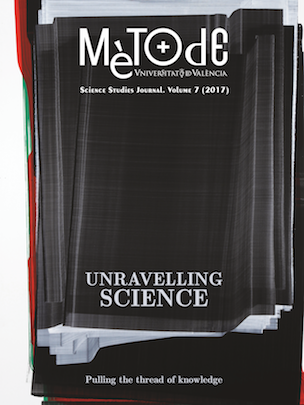Interstellar travel guide: Chronicles of a violent universe
DOI:
https://doi.org/10.7203/metode.7.8821Keywords:
relativity, black holes, neutron stars, active galaxies, hydrodynamics Abstract
Abstract
In contrast to observations from our local viewpoint, the universe is extremely violent. Explosions of massive stars, X-ray and gamma-ray binary stars, and active galaxies are related to the presence of compact objects such as neutron stars or black holes. Processes such as matter accretion or the formation and release of relativistic plasma jets are responsible for the generation of large amounts of high-energy radiation, caused by the acceleration of elementary particles, and have a significant impact in their surroundings. Moreover, they are related to the generation of gravitational waves: vibrations in spacetime produced by the acceleration of compact massive objects that produce strong curvatures. These systems are studied within the framework of the general and special relativity theories. In this article, we summarise several of the most well-known astrophysical scenarios, and offer a brief description of what we currently know about them.
 Downloads
Downloads
 References
References
Abbott, B. P., Abbott, R., Abbott, T. D., Abernathy, M. R., Acernese, F., Ackley, K., … Zweizig, J. (2016). Observation of gravitational waves from a binary black hole merger. Physical Review Letters, 116(6), 061102. doi: 10.1103/PhysRevLett.116.061102
Blandford, R. D., & Payne, D. G. (1982). Hydromagnetic flows from accretion discs and the production of radio jets. Monthly Notices of the Royal Astronomical Society, 199(4), 883–903. doi: 10.1093/mnras/199.4.883
Blandford, R. D., & Znajek, R. L. (1977). Electromagnetic extraction of energy from Kerr black holes. Monthly Notices of the Royal Astronomical Society, 179(3), 433–456. doi: 10.1093/mnras/179.3.433
Bolton, C. T. (1972). Identification of Cygnus X-1 with HDE 226868. Nature, 235, 271–273. doi: 10.1038/235271b0
Font, J. A., Sintes, A. M., & Sopuerta, C. F. (2015). Gravitational waves with the SKA. In M. A. Pérez-Torres (Ed.), The Spanish Square Kilometer Array white book (pp. 29–36). Barcelona: Sociedad Española de Astronomía. Retrieved from https://arxiv.org/abs/1506.03474
Gehrels, N., Ramírez-Ruiz, E., & Fox., D. B. (2009). Gamma-ray bursts in the Swift era. Annual Review of Astronomy and Astrophysics, 47, 567–617. doi: 10.1146/annurev.astro.46.060407.145147
Genzel, R., Eisenhauer, F., & Gillessen, S. (2010). The Galactic Center massive black hole and nuclear star cluster. Reviews of Modern Physics, 82, 3121–1395. doi: 10.1103/RevModPhys.82.3121
Goddi, C., Falcke, H., Kramer, M., Rezzolla, L., Brinkerink, T., Bronzwaer, T., ... Zhidenko, A. (2016). BlackHoleCam: fundamental physics of the galactic center. International Journal of Modern Physics D, 1730001. doi: 10.1142/S0218271817300014
Hewish, A., Bell, S. J., Pilkington, J. D. H., Scott, P. F., & Collins, R. A. (1968). Observation of a rapidly pulsating radio source. Nature, 217, 709–713. doi: 10.1038/217709a0
Hulse, R. A., & Taylor, J. H. (1975). Discovery of a pulsar in a binary system. Astrophysical Journal, 195, L51–L53. doi: 10.1086/181708
Janka, H. T. (2012). Explosion mechanisms of core-collapse supernovae. Annual Review of Nuclear and Particle Science, 62, 407–451. doi: 10.1146/annurev-nucl-102711-094901
Mościbrodzka, M., Falcke, H., Shiokawa, H., & Gammie, C. F. (2014). Observational appearance of inefficient accretion flows and jets in 3D GRMHD simulations: Application to Sagittarius A*. Astronomy & Astrophysics, 570, A7. doi: 10.1051/0004-6361/201424358
Netzer, H. (2013). The physics and evolution of active galactic nuclei. Cambridge: Cambridge University Press.
Piran, T., & Jiménez, R. (2014). Possible role of gamma ray bursts on life extinction in the universe. Physical Review Letters, 113(23), 231102. doi: 10.1103/PhysRevLett.113.231102
Shapiro, S. L., & Teukolsky, S. A. (2007). Black holes, white dwarfs, and neutron stars: The physics of compact objects. New York: Wiley Online Library. (Original work published in 1983). doi: 10.1002/9783527617661
Webster, B. L., & Murdin, P. (1972). Cygnus X-1 —A spectroscopic binary with a heavy companion? Nature, 235, 37–38. doi: 10.1038/235037a0
Downloads
Published
How to Cite
-
Abstract1488
-
PDF335
Issue
Section
License
![]()
All the documents in the OJS platform are open access and property of their respective authors.
Authors publishing in the journal agree to the following terms:
- Authors keep the rights and guarantee Metode Science Studies Journal the right to be the first publication of the document, licensed under a Creative Commons Attribution-NonCommercial-NoDerivatives 4.0 International License that allows others to share the work with an acknowledgement of authorship and publication in the journal.
- Authors are allowed and encouraged to spread their work through electronic means using personal or institutional websites (institutional open archives, personal websites or professional and academic networks profiles) once the text has been published.





